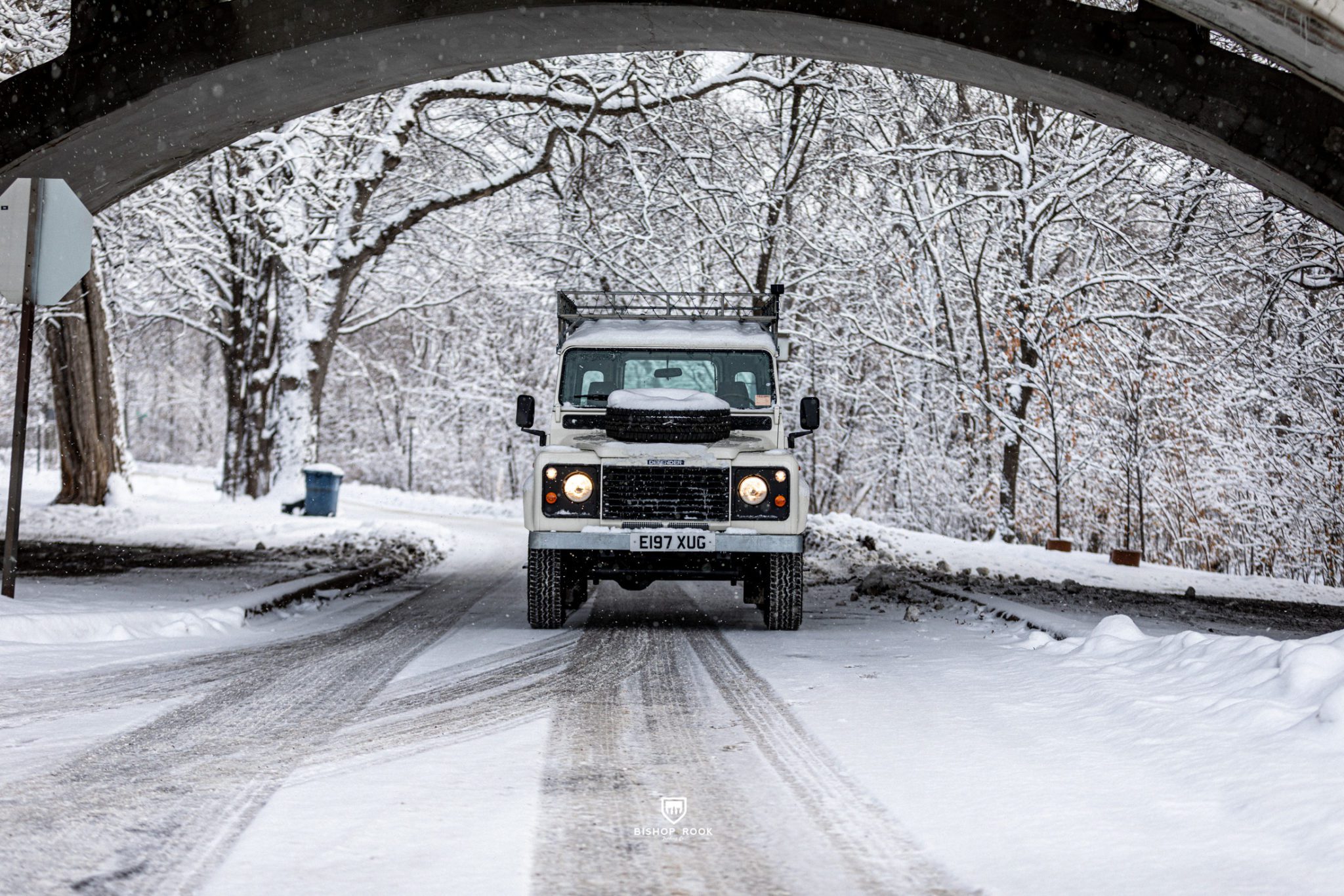If you’ve been researching Land Rover Defenders for any amount of time, you have likely come across heaps of custom Defenders that have shiny paint, perfectly trimmed seats, Apple CarPlay, and loads of pretty photos and videos of the finished project. What you probably haven’t seen is where those Defender builds started. That’s what we’re about to do with this post.
Every defender restoration starts with a donor vehicle to serve as the foundation for each restoration project. It’s our job to ensure each donor is a factory build Land Rover Defender that meets all the necessary requirements to be import/export eligible, including a verifiable history with paperwork confirmation. We often have to look at a lot of Defenders before we find ones that are suitable for this process.
The Ugly Defender Challenge Begins
The biggest issue we run into these days is that we come across too many Defenders that we end up falling in love with as they are and don’t want to take them apart for restoration. That presented our team with a unique challenge: what condition would a Defender need to be in where we had no choice but to take it apart for restoration? Better yet, could we find the ugliest and most neglected Defender we could and return it to factory (or better) condition?
To say that we are overachievers on this challenge would be an understatement. We didn’t even get very good photos of the donor Defender. When we saw the first shot, we were sold.

The Land Rover Defender Beauty Makeover Begins
We start every project with a couple of days of disassembly. In this case, we added a bit of gardening work to the schedule to take care of the various plants and animals that had taken root inside the chassis and interior. In the car world, when someone talks about a “True Barn Find”, they’re generally referencing finding a hidden gem in the back of a barn someplace out in the country. In our case, we’re going to say, with great confidence, that we have found the first “This Car Was Used As a Barn Find.”
Disassembly went surprisingly well. We had done quite a bit of digging into the donor to ensure the chassis was solid – despite being hidden under layers and layers of mud.

The engine bay and interior were no better. But under all the dirt, there was a solid base for a Defender build. We were very happy.

 If anyone can guess what the mystery organic matter is in the back of this Defender, we’ll send you a free gift – t-shirt, keychain, or a complementary tetanus shot.
If anyone can guess what the mystery organic matter is in the back of this Defender, we’ll send you a free gift – t-shirt, keychain, or a complementary tetanus shot.
Uncovering A Hidden Defender Gem
The pressure washer and hand grinders came in very handy at this stage of the build. Admittedly, we might have needed to use a shovel and a bit of scraping, as well.
 Once the chassis was free of most of the foreign matter, we began the process of stripping off the old paint. Sometimes we will send the chassis out to media blasting and other times we will elect to strip the chassis by hand. My personal preference is to do this job by hand because it gets you closer to the project and ensures that someone has touched every single square inch of the project on the team. Media blasting is far faster, of course.
Once the chassis was free of most of the foreign matter, we began the process of stripping off the old paint. Sometimes we will send the chassis out to media blasting and other times we will elect to strip the chassis by hand. My personal preference is to do this job by hand because it gets you closer to the project and ensures that someone has touched every single square inch of the project on the team. Media blasting is far faster, of course.
 After a couple days of this process, which includes removing the rest of the suspension components, fuel lines, brake lines, etc., we were ready to prime and paint the chassis. Unlike some of the projects in our UK workshop, this Spanish chassis didn’t require one bit of welding. This is the part that starts to make the project come to life.
After a couple days of this process, which includes removing the rest of the suspension components, fuel lines, brake lines, etc., we were ready to prime and paint the chassis. Unlike some of the projects in our UK workshop, this Spanish chassis didn’t require one bit of welding. This is the part that starts to make the project come to life.
 The epoxy primer helps seal the raw chassis and serves as a base for the chassis paint to bond to. The chassis is quite heavy, so we tend to get creative in the ways in which we hold them off the ground for painting.
The epoxy primer helps seal the raw chassis and serves as a base for the chassis paint to bond to. The chassis is quite heavy, so we tend to get creative in the ways in which we hold them off the ground for painting.

We had to do a little bit of repair work to the bulkhead, as some of the mud, dirt, and chicken poo had eaten through some of the bottoms of the footwells. This is a pretty standard part of the restoration process. There have been times when we’ve gotten halfway through a bulkhead restoration only to discover someone had been there before us with some evil repairs that can’t be undone – or unseen in many cases The option of using a new or galvanized bulkhead is always in the backs of our minds – as it’s an area that often gets pretty dinged up after 25+ years of farm work.
 We’re of the mindset of preserving and restoring as much of the original vehicle as possible. To us, that’s where the story and soul of the Defender lives. We could certainly replace every single panel on this Defender, but what’s the fun in that?
We’re of the mindset of preserving and restoring as much of the original vehicle as possible. To us, that’s where the story and soul of the Defender lives. We could certainly replace every single panel on this Defender, but what’s the fun in that?
Building Back To Factory Condition
We had to replace nearly every door skin on the build but were surprised to find most of the door frames in exceptional condition. Our bodywork team can pull off some big miracles during the restoration process. While the disassembly process can take a day or two, the re-assembly process takes a bit more time. A lot more time, come to think of it.
If you were to ask me how long it takes to restore a Defender, I would say this: about a day to take apart and about 11 months and 29 days to put it back together.

When we do a nut-and-bolt restoration, we take off every single panel, bracket, fastener, and seal to ensure that every single component of the Defender is properly refreshed, replaced, or restored. A “body-off” restoration by some shops might mean they took the panels/doors or top off the project and painted it quickly. When we talk about a panel-off restoration, we ensure that every element of the Defender is touched – that’s the only way to know you’ve done your job right. It takes a lot of time and effort, but it’s worth it when you find yourself driving a Defender that feels like it just rolled off the Solihull factory floor.

Original factory Land Rover Defender steel wheels painted to match the roof. As it should be.
 We retrim the factory seats and door cards to give it an original heritage look, but with a little bit of extra style. In the case of this build, we didn’t want to go too much over the top – just a nice simple black leather interior to retain the simplicity of the original design.
We retrim the factory seats and door cards to give it an original heritage look, but with a little bit of extra style. In the case of this build, we didn’t want to go too much over the top – just a nice simple black leather interior to retain the simplicity of the original design.
Trust In The Process
I always hated the statement “trust in the process,” but sometimes you need to have faith that a process will get you to the result you’re hoping for. In our case, we’ve learned a lot over the years of restoring vintage Land Rover Defenders. There’s no easy way to speed up the process, nor are there shortcuts that should be taken. It’s a painfully slow process at times, as we finish certain elements of a build and wait for other components or parts to arrive.
We’ve experimented with various approaches to taking on a restoration project like this but found the only way to have good results is to go step-by-step – slowly – not jumping ahead to a future stage before you finish the component you’re working on. It takes between 1,000 and 1,800 hours to complete a Heritage Defender restoration project. Some of those hours run concurrently, but assembly always follows the same path.
As we complete major milestone stages, we can document what we’ve completed, test the components, double-check each other’s work, and finally sign off so we can move to the next stage of the project.

The Final Result
We’re still finishing up a few small elements of this build but will feature the final project in part II of this series, once we’ve completed our testing period and make time to take the project out for some proper photos and video. Sign up for the newsletter, or send us a message below if you want to stay updated.
Additionally, if you’re interested in chatting with us about a custom Defender build of your own, reach out with any questions you might have. We’re not much for the sales pitch, other than to say: we enjoy building Defenders and would love to make one for you.




















You must be logged in to post a comment.